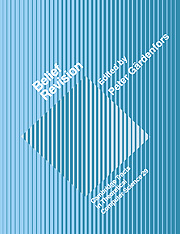Book contents
- Frontmatter
- Contents
- Belief revision: An introduction
- Reason maintenance and belief revision: Foundations versus coherence theories
- Syntax based approaches to belief revision
- A dyadic representation of belief
- On the logic of theory change: More maps between different kinds of contraction functions
- Belief change and possibility theory
- On the difference between updating a knowledge base and revising it
- Planning from first principles
- Autonomous belief revision and communication
- Conditionals and knowledge-base update
- Index
Syntax based approaches to belief revision
Published online by Cambridge University Press: 21 September 2009
- Frontmatter
- Contents
- Belief revision: An introduction
- Reason maintenance and belief revision: Foundations versus coherence theories
- Syntax based approaches to belief revision
- A dyadic representation of belief
- On the logic of theory change: More maps between different kinds of contraction functions
- Belief change and possibility theory
- On the difference between updating a knowledge base and revising it
- Planning from first principles
- Autonomous belief revision and communication
- Conditionals and knowledge-base update
- Index
Summary
INTRODUCTION
Belief revision is the process of incorporating new information into a knowledge base while preserving consistency. Recently, belief revision has received a lot of attention in AI, which led to a number of different proposals for different applications (Ginsberg 1986; Ginsberg, Smith 1987; Dalal 1988; Gärdenfors, Makinson 1988; Winslett 1988; Myers, Smith 1988; Rao, Foo 1989; Nebel 1989; Winslett 1989; Katsuno, Mendelzon 1989; Katsuno, Mendelzon 1991; Doyle 1990). Most of this research has been considerably influenced by approaches in philosophical logic, in particular by Gärdenfors and his colleagues (Alchourrón, Gärdenfors, Makinson 1985; Gärdenfors 1988), who developed the logic of theory change, also called theory of epistemic change. This theory formalizes epistemic states as deductively closed theories and defines different change operations on such epistemic states.
Syntax-based approaches to belief revision to be introduced in Section 3 have been very popular because of their conceptual simplicity. However, there also has been criticisms since the outcome of a revision operation relies an arbitrary syntactic distinctions (see, e.g., (Dalal 1988; Winslett 1988; Katsuno, Mendelzon 1989))—and for this reason such operations cannot be analyzed on the knowledge level. In (Nebel 1989) we showed that syntax-based approaches can be interpreted as assigning higher relevance to explicitly represented sentences. Based on that view, one particular kind of syntax-based revision, called base revision, was shown to fit into the theory of epistemic change. In Section 4 we generalize this result to prioritized bases.
- Type
- Chapter
- Information
- Belief Revision , pp. 52 - 88Publisher: Cambridge University PressPrint publication year: 1992
- 70
- Cited by



